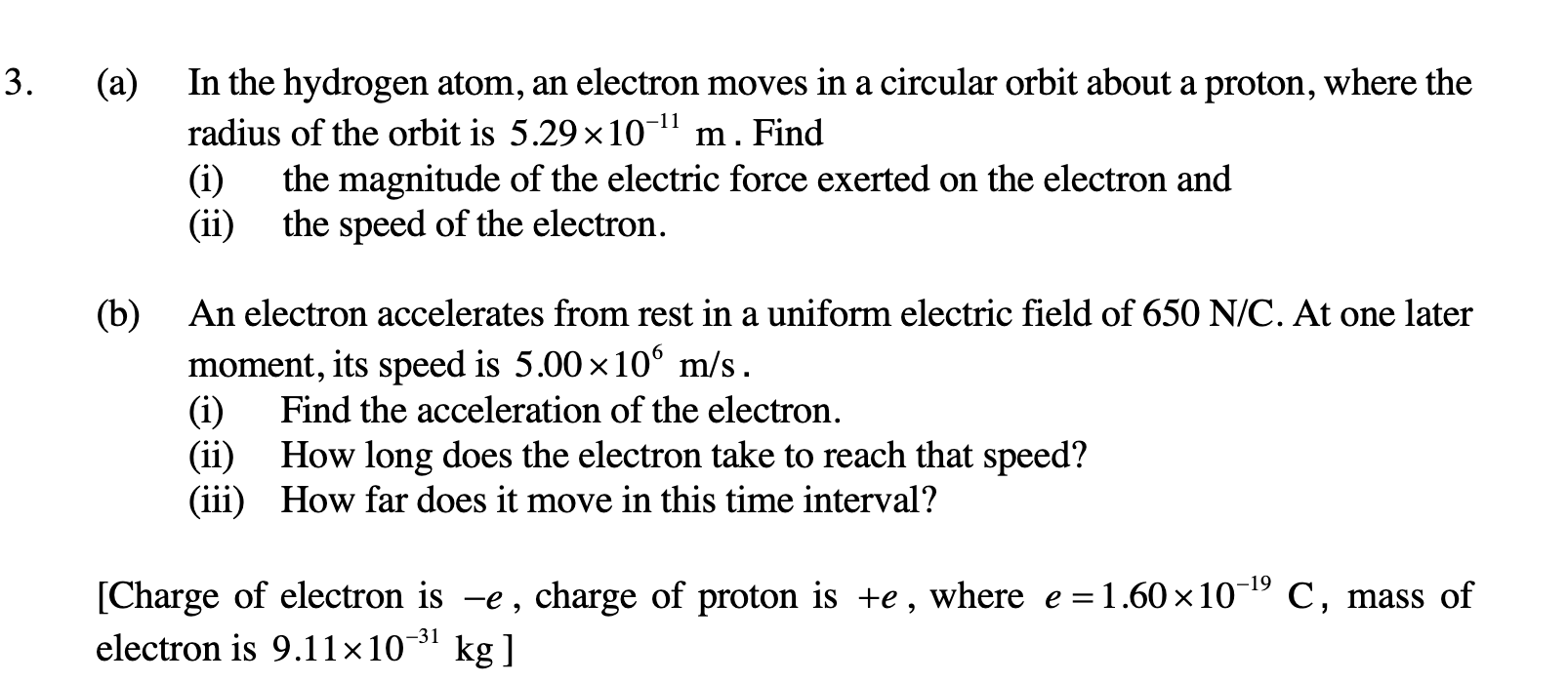a) In the hydrogen atom, an electron moves in a circular orbit about a proton, where the radius of the orbit is 5.29 x 10^-11 m. Find: i) the magnitude of the electric force exerte... a) In the hydrogen atom, an electron moves in a circular orbit about a proton, where the radius of the orbit is 5.29 x 10^-11 m. Find: i) the magnitude of the electric force exerted on the electron and ii) the speed of the electron. b) An electron accelerates from rest in a uniform electric field of 650 N/C. At one later moment, its speed is 5.00 x 10^6 m/s. i) Find the acceleration of the electron. ii) How long does the electron take to reach that speed? iii) How far does it move in this time interval?

Understand the Problem
This question is about the behavior of electrons in electric fields. Part (a) is asking us to calculate the electric force on an electron orbiting a proton in a hydrogen atom, and then to find the speed of the electron. Part (b) deals with an electron accelerating in a uniform electric field, asking us to find the acceleration, the time it takes to reach a certain speed, and the distance it travels in that time.
Answer
(a) (i) $8.22 \times 10^{-8} \, \text{N}$ (a) (ii) $2.18 \times 10^6 \, \text{m/s}$ (b) (i) $1.14 \times 10^{14} \, \text{m/s}^2$ (b) (ii) $4.39 \times 10^{-8} \, \text{s}$ (b) (iii) $0.11 \, \text{m}$
Answer for screen readers
(a) (i) $8.22 \times 10^{-8} , \text{N}$ (a) (ii) $2.18 \times 10^6 , \text{m/s}$ (b) (i) $1.14 \times 10^{14} , \text{m/s}^2$ (b) (ii) $4.39 \times 10^{-8} , \text{s}$ (b) (iii) $0.11 , \text{m}$
Steps to Solve
- (a)(i) Calculate the electric force
The electric force between the electron and proton is given by Coulomb's law:
$F = k \frac{|q_1 q_2|}{r^2}$
where $k = 8.9875 \times 10^9 , \text{N m}^2/\text{C}^2$ is Coulomb's constant, $q_1$ and $q_2$ are the charges of the proton and electron respectively, and $r$ is the distance between them. Since the charge of the proton is $+e$ and the charge of the electron is $-e$, we have $|q_1 q_2| = e^2$. Plugging in the values:
$F = (8.9875 \times 10^9) \frac{(1.60 \times 10^{-19})^2}{(5.29 \times 10^{-11})^2}$
- Simplify and find the electric force
$F = (8.9875 \times 10^9) \frac{2.56 \times 10^{-38}}{2.79841 \times 10^{-21}}$
$F = \frac{2.3008 \times 10^{-28}}{2.79841 \times 10^{-21}}$
$F \approx 8.22 \times 10^{-8} , \text{N}$
- (a)(ii) Find the speed of the electron
Since the electric force provides the centripetal force for the electron's circular motion, we can equate the electric force to the centripetal force:
$F = \frac{mv^2}{r}$
Where $m$ is the mass of the electron and $v$ is its speed. Rearrange to solve for $v$:
$v = \sqrt{\frac{Fr}{m}}$
- Plug in values and find the electron speed
$v = \sqrt{\frac{(8.22 \times 10^{-8})(5.29 \times 10^{-11})}{9.11 \times 10^{-31}}}$
$v = \sqrt{\frac{4.348 \times 10^{-18}}{9.11 \times 10^{-31}}}$
$v = \sqrt{4.773 \times 10^{12}}$
$v \approx 2.18 \times 10^6 , \text{m/s}$
- (b)(i) Find the acceleration of the electron
The force on the electron due to the electric field is $F = qE$, where $q$ is the charge of the electron and $E$ is the electric field strength. Using Newton's second law, $F = ma$, therefore $a = \frac{F}{m} = \frac{qE}{m}$.
$a = \frac{(1.60 \times 10^{-19})(650)}{9.11 \times 10^{-31}}$
- Simplify and find the acceleration
$a = \frac{1.04 \times 10^{-16}}{9.11 \times 10^{-31}}$
$a \approx 1.14 \times 10^{14} , \text{m/s}^2$
- (b)(ii) Find the time to reach the speed
We can use the equation $v = v_0 + at$, where $v_0$ is the initial velocity (0 in this case), $v$ is the final velocity, $a$ is the acceleration, and $t$ is the time. Solving for $t$:
$t = \frac{v - v_0}{a} = \frac{v}{a}$
$t = \frac{5.00 \times 10^6}{1.14 \times 10^{14}}$
- Simplify and find the time
$t \approx 4.39 \times 10^{-8} , \text{s}$
- (b)(iii) Find the distance traveled
We can use the equation $d = v_0t + \frac{1}{2}at^2$. Since $v_0 = 0$, we have:
$d = \frac{1}{2}at^2$
$d = \frac{1}{2}(1.14 \times 10^{14})(4.39 \times 10^{-8})^2$
- Simplify and find the distance
$d = \frac{1}{2}(1.14 \times 10^{14})(1.927 \times 10^{-15})$
$d = (0.57 \times 10^{14})(1.927 \times 10^{-15})$
$d \approx 0.11 , \text{m}$
(a) (i) $8.22 \times 10^{-8} , \text{N}$ (a) (ii) $2.18 \times 10^6 , \text{m/s}$ (b) (i) $1.14 \times 10^{14} , \text{m/s}^2$ (b) (ii) $4.39 \times 10^{-8} , \text{s}$ (b) (iii) $0.11 , \text{m}$
More Information
The electric force in the hydrogen atom is what keeps the electron bound to the proton, creating a stable atom. Also, the calculation for the velocity of the electron is a non-relativistic calculation, as the electron's speed is far less than the speed of light.
Tips
A common mistake is forgetting to square the radius in Coulomb's law. Another is using the wrong sign for the electron charge, though the absolute value takes care of that in this problem. Also, it would be easy to make a mistake calculating the square root. In the second part of the question, using the wrong kinematic equation or making a mistake in unit conversion could lead to errors.
AI-generated content may contain errors. Please verify critical information